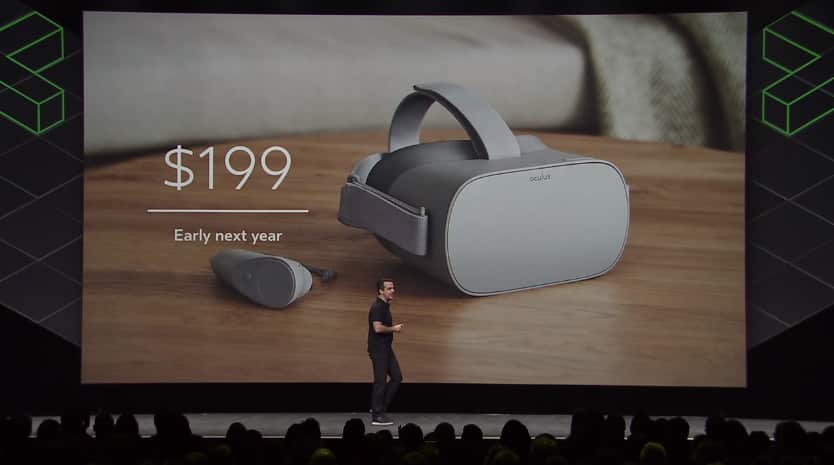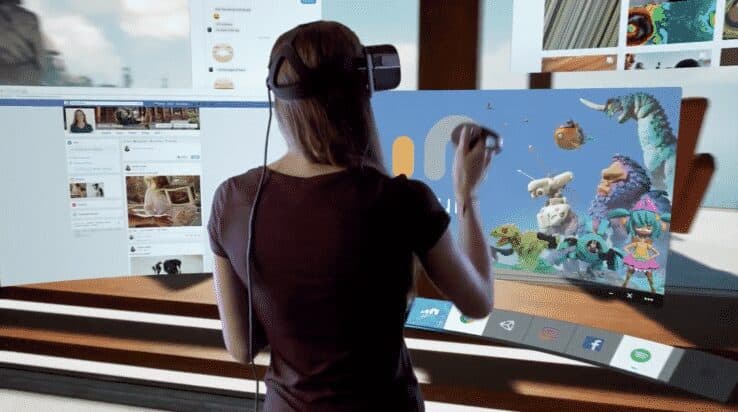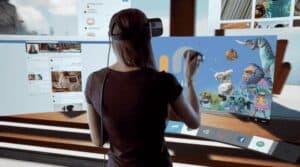At the annual Oculus Connect OC4 conference today, Mark Zuckerberg made the case for VR as the next computing platform for work, play, and entertainment. In an hour and a half, Zuckerberg and his team went through a range of announcements, use cases and upcoming releases to reveal where virtual reality is headed. At least according to Facebook’s vision.
Facebook’s goal is now official: they want to see 1 Billion people in Virtual Reality. What’s going to get that many people in VR? It’s all in the insights from today’s keynote.
Oculus Go: a new headset and controllers

The big news came early: Oculus is announcing a new standalone VR headset. The new Oculus Go specs put the headset between mobile HMD’s like Samsung’s Gear VR and the high-end Oculus Rift. It doesn’t have inside-out tracking or fully tracked motion controllers, which helps keep the price down. It’s not as full-featured as the new Microsoft Mixed Reality headsets, but you won’t be tethered to a computer. Oculus Go will ship early next year for a very affordable $199.
Oculus head Hugo Barra referred to Go as “hands-down the easiest way to get into VR.” Among other things, it has new lens design and a resolution of 2560 x 1440 which is a step up from RIft’s 2160 x 1200. It has spatial audio built into the headset, which means it can be used without headphones.
The controllers are similar to the Gear VR’s remote. Everything that works on GearVR is going to work on Oculus Go. One of the less noticed themes into today’s announcements was that Gear VR would be integrated more closely into the Oculus ecosystem.
Developers will be able to get their hands on the new HMD in November with the consumer version coming in spring 2018.
Updates to the Santa Cruz prototype
Last year at OC3, Facebook shared drawings for project Santa Cruz, a prototype for new self-contained VR headset with inside-out tracking. With little news over the past year, today’s progress report was highly anticipated.
Santa Cruz is a wireless VR headset that works without external cameras or sensors to track your position in the room. It includes two newly designed wireless controllers. The new controllers feature a large circular touchpad that replaces the thumbstick on the Rift versions.
Interestingly, the entire design is flipped upside down. The controller ring with its infrared LEDs now faces upwards to that it can be tracked by sensors in the headset. Hugo Barra said,
Getting the infrared LEDs on our new Santa Cruz controllers to work with the sensors used for inside-out tracking on the headset was a significant computer vision, design, and engineering problem.
By placing four sensors around the rim of the headset, the HMD can track both the position of the user and the controllers. When released, the Santa Cruz headset will be the first high-end VR system from Oculus that doesn’t require being tethered to a powerful PC.
Developers will get access to the Santa Cruz headset next year. There’s no release date on the consumer model. You may buy the new Oculus Go headset in the spring, but this is the model you really want.
Social VR Experiences
Developing VR as the next computing platform means creating spaces for social interaction, moving beyond the idea that VR is an isolating space. Today, Zuckerberg announces Oculus Venues, a new experience coming next year that will let people watch live concerts, sports, and movie premieres with thousands of other people around the world.
Facebook Spaces
The keynote also included updates on Facebook Spaces, an app only available on the Oculus Rift. In Spaces people can meet and share photos and videos using virtual pop-up screens, and access a set of virtual tools to doodle and add sunglasses and hats. Starting today users will be able to play a number of low-key games, like cards and dice in VR. In addition, Facebook will now let Spaces users stream its existing library of 360-degree video.
3D Posts
To connect the Virtual and Physical world, Facebook introduced what it calls 3D Posts, which are simple, interactive 3D objects that can be crafted using the new creative tools in Spaces and then be taken out of VR and posted directly to a Facebook feed.
Finally, the Oculus VR tool Quill, a stylized drawing tool created for the VR film Dear Angelica will be now available in Spaces and allow users to illustrate and do creative work. Though we’re hooked on Google’s Tilt Brush app, we’ve been waiting for Facebook to release Quill.
Oculus Home and Dash
 Oculus Connect also revealed that Oculus Home is getting a makeover which will let you turn your startup screen for Rift into a fantasy place. You can customize the environment, and exhibit personalized objects, badges, and trophies. It is hard not to think of the movie Ready Player One when seeing what Facebook is creating with Oculus Home.
Oculus Connect also revealed that Oculus Home is getting a makeover which will let you turn your startup screen for Rift into a fantasy place. You can customize the environment, and exhibit personalized objects, badges, and trophies. It is hard not to think of the movie Ready Player One when seeing what Facebook is creating with Oculus Home.
In addition, the Oculus Rift will get a whole new user interface that lets you customize your VR Home space and bring your computer screen and apps inside VR. Floating screens will be available for anything you can do on a computer. The UI feels very much inspired by the movie Minority Report.
Indeed, developers will even be able to code and debug in VR. The Oculus Core 2.0 software update is scheduled to be released in beta in December.
Tomorrow’s VR keynote at Oculus Connect
The first day of Occulus Connect has shown Facebook’s vision for VR. It’s not simply about the hardware and software that will power the next wave of immersive experiences. It’s Facebook’s effort to turn virtual reality into the computing platform of the future.
In different ways, that vision is shared by Google and Microsoft. Each is pushing VR beyond the early stage of emerging technology, to where it impacts education, business, and entertainment. And becomes deeply intertwined in our social lives.
Will a billion people jump on board as Zuckerberg predicts? Not in the coming year. But the new developments announced at Oculus Connect will rapidly increase the pace of adoption. Watching the keynotes today, we couldn’t help but think back 3-4 years ago and realize how far we’ve come.
And we’re just getting started.
On Thursday, Oculus CTO John Carmack takes the stage for the Day 2 Keynote. Join us as we live-stream the event and get a deeper look at our future.
Maya Georgieva is an EdTech and XR strategist, futurist and speaker with more than 15 years of experience in higher education and global education policy. Her most recent work focuses on innovation, VR/AR and Immersive storytelling, design and digital strategy. Maya actively writes and speaks on the topics of innovation, immersive storytelling and the future of education and consults organizations and startups in this space.

